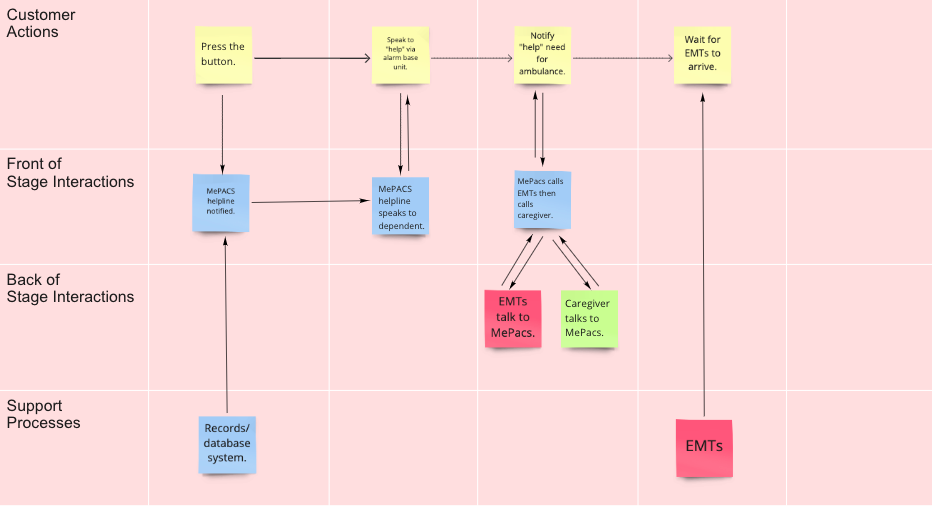“Increasing adoption and utility of personal alarms”
A UX-turned-service design concept project for MePACS.
PROJECT OVERVIEW
The brief: MePACS is a personal emergency response system company. The challenge was to reduce people’s reluctance to use the service and seek opportunities to extend the utility of the service for subscribers.
The problem: Poor communication flow and poor product design.
The solution: Our overarching solution was to humanise the service. In the short-term, this involved rethinking the processes for acquiring the service, improving the communication flow during service delivery, and re-designing aspects of the website. A longer-term strategy was also provided, that included an app to further facilitate communication between parties, and a product re-design that included biometric and other extensions.
The deliverables: Service and website design recommendations (including wireframes and interactive prototype); detailed documentation of the research and synthesis; a 30-minute presentation explaining the project and selling the recommendations.
The process: User research through to service and website design, including synthesis and iteration.
Key methods:
● Competitor and comparator analysis.
● Surveying and interviewing.
● Contextual research.
● Secondary research.
● Usability testing.
● Affinity & journey mapping.
● Wireframing & prototyping.
Key tools: Figma
My role: UX researcher and designer; involved in all aspects/activities of the project.
The set-up: A three week sprint, in a team of two (working both in person and remotely).
Read on to see our design journey OR jump to…
RESEARCH
Personal alarm services are complicated, and have to meet many different needs.
Personal alarm services involve many parties including the person being cared for (the dependent), the people responsible for the dependent (the caregivers), and the Emergency Medical Technicians (EMTs). We quickly discovered that it’s the caregivers, not the dependents, who make the decision to subscribe to a personal alarm service. Therefore, we had to consider and address their needs, as well as those of the dependents.
Dependents
MePACS
Caregivers
EMTs
Defining our target users helped narrow our focus.

We had to get creative to uncover the issues.
From interviews and surveys, we began to understand what people expect from such a service. However, we had to get creative with our research because we didn’t have access to a lot of people who have used these services. Therefore, we supplemented our knowledge by involving people who are likely to find themselves as a caregiver in the future (people we deemed ‘hypothetical’ caregivers). In the end, we drew insights from:
● 2 caregivers, one with a current dependent.
● 6 hypothetical caregivers.
● 1 employee of a competitor’s service.
● 1 MePACS sales staff member.
10 user interviews
surveys
These were our findings and opportunities.
We discovered a number of obstacles to acquiring these services, and learned that caregivers, in particular, have high expectations. We also found that:
● Caregivers value updated information about dependents.
● Poor communication flow is disconnecting parties.
● The product itself is seen as ugly, awkward and has a stigma attached to it.
● Dependents (older generations especially) trust in humans and what they know, however are more distrusting to something new.
● There are positive sentiments around preventative monitoring.

There are many bumps in the road…
We analysed the end-to-end process to understand the opportunities and challenges. This helped us prioritise the most pressing concerns. We discovered the most pressing steps in the process were in deciding the need for the service and then in an actual emergency situation. The severity of each of these pain points at each stage in the customer journey are represented by the size of the circles below.

… and gaps to be filled.
Creating service blueprints for these two steps in the process enabled us to visualise what’s going on in the organisation and understand some of the the implications of potential process changes.
The dependent is hardly involved in the “deciding need for service” stage and “in an emergency”, the caregiver, is hardly a part of the process either. We needed both of these people involved in the service at the right times and in the right way in order to solve the business problems.
2 x service blueprints
Deciding need for service (customer = caregiver)
Creating service blueprints for these two steps in the process (establishing the need to acquire the service and in an emergency situation) enabled us to visualise what’s going on in the organisation and understand some of the the implications of potential process changes.
The dependent is hardly involved in the “deciding need for service” stage and “in an emergency”, the caregiver, is hardly a part of the process either. We needed both of these people involved in the service at the right times and in the right way in order to solve the business problems.
Caregivers
MePACS
Dependents

In an emergency (customer = dependent)
Creating service blueprints for these two steps in the process (establishing the need to acquire the service and in an emergency situation) enabled us to visualise what’s going on in the organisation and understand some of the the implications of potential process changes.
The dependent is hardly involved in the “deciding need for service” stage and “in an emergency”, the caregiver, is hardly a part of the process either. We needed both of these people involved in the service at the right times and in the right way in order to solve the business problems.
Dependents
MePACS
Caregivers
EMTs

SOLUTIONS
Synthesising immediate and long term recommendations.
Affinity mapping allowed us to synthesise all of the data we had collected in our research methods into core recommendations for now and into the future.

Getting the best bang for the buck.
The two immediate steps that deliver the highest impact for the least cost/effort:
● Improving the website &
● improving information flow for the care circle.
Underpinning both of these is the need to ‘humanise’ the experience and the process.

A few quick website changes will make it more useful and usable.
● Further “humanise the experience” by using vocabulary such as “human touch” and “care” on the homepage where it would be most visible and changing the drop down “product” category tab to “services”, shifting the current focus from products to services.
● Build trust with the viewer with headings including words such as “professional”, “keeping you safe 24/7” and the trustpilot star rating linking to reviews.
● Introduce a new 3 tier service model (the proposed “Complete Care” tier provides the most complete insurance of safety including a 1/2 hour in home visit from one of MEPACS friendly customer care specialists, which includes a catch up chat and checking on the service.
● Add a sign in option for caregivers to access information about dependents like daily/monthly check ins, alarm status, emergency history, health information and service tier information where customers can update or downgrade their service.
● Minimise and simplify the content and design (e.g. reduce the drop down list under products from 6 to 2), as information is currently repeated and overwhelming for the user.

Several (relatively) simple recommendations for delivering a
better service.
Initial inquiry: Use call software (e.g., Pipedrive) for staff to record relevant information (health/medical and personal), also any information about the customers and their motivations for the device and concerns etc. This will all be very valuable info for follow-up and also if the client enquires or subscribes with MePACS in the future. In this initial phone consult we also recommend emphasising MePACS’ value proposition to express the point of difference in the industry, and offer a follow-up call. Follow up calls can simply be scheduled into the program for reminders and then the calls made accordingly.
Installation: Introduce a face-to-face in-home visit for all customers (install/delivery/training/chat).
This is not only to ensure safety and peace of mind of the alarm system, but, also as an opportunity for a friendly “Customer Care Specialist” from MePACS to meet the client face-to-face and further develop the relationship with the client.
Daily check-in: Record information updated onto the website in such a way that the caregiver can be kept informed about the dependent’s health status, both from the daily check-ins and any other encounters.
Monthly visit: Offer additional visits as part of an optional (“Complete Care”) service. In this visit the MePACS’ “Customer Service Specialist” would complete any device checks, reiterate and evaluate training of alarm systems and, most importantly, connect with the client and see how they are doing and continue to build this positive relationship. The information of this visit would be recorded onto the website for caregivers to view and also in MePACS call software program to keep the paper trail of every single valued customer.
Emergencies: MePACS operator stays connected with dependent on line & obtains information from EMT. If MePACS obtain information about what hospital the patient will be taken to and their current status, it would be extremely valuable information for the caregivers, as MePACS could directly update the carers on a phone call and also on the website.
More ambitious changes in the future.
Beyond the short-term fixes, there are several opportunities to help MePACS continue to be relevant far into the future:
● Design an app, as an extension of the website account page, and also to support future features.
● Conduct further research around users’ sentiments towards the use of cameras in their homes and incorporating monitoring/biometrics to the alarm device.
● Further research around the ideal redesign of the device.
● Research partnering with biometrics or other tech companies for funding to advance technologies used.
Looking backwards.
We felt very enthusiastic about the potential of these design ideas. This is obviously just the beginning , and a lot more work needs to be undertaken, but we are confident that these solutions have the potential to make significant improvements — not only to the customers, but also for the business now and into the future. This project is a perfect example of how the role of service and UX design are two sides of the same coin, both working to best improve the user experience.
Linkedin
Phone
Envelope
View my other projects
Copyright © [hfe_current_year] [hfe_site_title]

